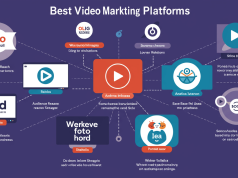Video content dominates modern marketing, but creating great videos is only half the battle. The other half? Making sure your target audience can actually find them. Video marketing SEO combines the engagement power of video with strategic optimization techniques to boost your content’s visibility in search results.
Search engines process over 8.5 billion searches daily, and video content appears in 26% of search results. This presents a massive opportunity for brands that understand how to optimize their video content for search engines. When done correctly, video SEO can dramatically increase your organic reach, drive qualified traffic, and improve overall marketing ROI.
Understanding Video SEO Fundamentals
Video SEO involves optimizing your video content to rank higher in search engine results pages (SERPs). This includes both traditional search engines like Google and video-specific platforms like YouTube, which functions as the world’s second-largest search engine.
Search engines can’t watch videos the same way humans do. Instead, they rely on text-based signals to understand video content and determine relevance for specific search queries. These signals include titles, descriptions, tags, captions, and surrounding webpage content.
Video SEO differs from traditional SEO in several key ways. Videos often rank for different types of queries than text-based content, particularly “how-to” searches and visual demonstrations. Video results also occupy more visual space in search results, potentially increasing click-through rates.
The rise of video-first platforms has created new optimization opportunities. TikTok, Instagram Reels, and YouTube Shorts each have unique algorithms and ranking factors that affect content visibility. Understanding these differences helps you tailor your optimization approach for each platform.
Video Keyword Research Strategies
Effective video SEO starts with comprehensive keyword research. Video content often targets different search intent than text-based content, making specialized keyword research essential for success.
Start by identifying your primary topic and expanding into related keywords that indicate visual search intent. Terms like “how to,” “tutorial,” “demo,” “walkthrough,” and “guide” signal that users might prefer video content over text articles.
Use YouTube’s search suggest feature to discover popular video-related keywords. Start typing your main topic and note the autocomplete suggestions. These represent real searches performed by users and can reveal valuable keyword opportunities.
Analyze competitor video content to identify keyword gaps and opportunities. Look at successful videos in your niche and examine their titles, descriptions, and tags. Tools like VidIQ and TubeBuddy can help you analyze competitor video performance and identify optimization opportunities.
Consider long-tail keywords that match specific user questions or problems. Video content often ranks well for conversational queries and voice searches, which tend to be longer and more specific than traditional text searches.
Optimizing Video Titles and Descriptions
Your video title is the most important ranking factor for video SEO. It should clearly communicate your video’s topic while incorporating your primary keyword naturally. Keep titles under 60 characters to ensure they display fully in search results.
Front-load your titles with the most important keywords while maintaining readability. Instead of “Amazing Tips for Social Media Marketing Success,” try “Social Media Marketing: 5 Proven Strategies to Boost Engagement.” This approach prioritizes keywords while remaining compelling to users.
Video descriptions provide crucial context for search engines and viewers. Write detailed descriptions that explain your video’s content, include relevant keywords naturally, and provide additional value to viewers. Aim for 200-500 words for optimal SEO impact.
Structure your descriptions strategically. Include your primary keyword in the first 125 characters, as this text appears in search results. Use the remaining space to provide comprehensive information about your video’s content, benefits, and relevant details.
Add timestamps to longer videos to improve user experience and create additional keyword opportunities. Timestamps help viewers navigate your content and can appear as rich snippets in search results, potentially increasing click-through rates.
Technical Video SEO Optimization
Technical optimization ensures search engines can properly index and rank your video content. This includes both on-page elements and video file optimization.
Choose descriptive filenames for your video files before uploading. Instead of “video001.mp4,” use “social-media-marketing-tips-2024.mp4.” This helps search engines understand your content before processing any metadata.
Optimize video thumbnails for both platforms and search engines. Custom thumbnails should be visually appealing and accurately represent your content. Use high-contrast colors, clear text, and compelling imagery to improve click-through rates.
Add closed captions and transcripts to improve accessibility and SEO. Search engines can index caption text, providing additional context about your video’s content. This is particularly important for YouTube SEO, where captions can significantly impact rankings.
Implement schema markup for videos hosted on your website. Video schema helps search engines understand your content structure and can enable rich snippets in search results. This markup should include details like duration, upload date, and description.
Platform-Specific Video SEO

Different platforms have unique algorithms and ranking factors that affect video visibility. Understanding these differences helps you optimize content for each platform’s specific requirements.
YouTube SEO focuses heavily on engagement metrics like watch time, retention rate, and user interaction. Optimize for these factors by creating compelling hooks in your first 15 seconds, maintaining viewer interest throughout, and encouraging likes, comments, and shares.
YouTube’s algorithm also considers video freshness and consistency. Regular uploading schedules can improve channel authority and individual video performance. Create series or themed content to encourage binge-watching and improve overall channel metrics.
For website-hosted videos, focus on page-level SEO factors. Ensure your video is embedded on pages with relevant, high-quality content. The surrounding text should provide context and include relevant keywords that support your video’s topic.
Social media platforms like TikTok and Instagram prioritize engagement and shareability. Create content that encourages interaction, uses trending sounds or hashtags, and aligns with current platform trends. These platforms often favor native content over cross-posted videos.
Leveraging Different Video Types for SEO
Different video types serve various search intents and ranking opportunities. Understanding which formats work best for specific keywords helps you create more effective SEO strategies.
Explainer videos perform exceptionally well for educational queries and “what is” searches. These videos often rank in featured snippets and knowledge panels, providing high-visibility placement in search results. Focus on clear, concise explanations that directly answer user questions.
Tutorial and how-to videos dominate instructional searches. These videos often rank for high-intent keywords where users are actively seeking solutions. Structure tutorials with clear steps, use descriptive titles, and include relevant keywords throughout your content.
Product demonstration videos work well for commercial searches and comparison queries. These videos often appear in shopping results and product-specific searches. Include product names, model numbers, and relevant specifications in your optimization.
Behind-the-scenes and brand story videos can rank for brand-related searches and industry topics. While these may have lower search volumes, they often face less competition and can help establish topical authority in your niche.
Measuring Video SEO Performance
Tracking the right metrics helps you understand your video SEO effectiveness and identify optimization opportunities. Different platforms provide various analytics tools and metrics.
Monitor organic traffic from search engines to your video content. Use Google Analytics to track how users discover your videos through search and their behavior after viewing. This data helps you understand which optimization strategies drive the most valuable traffic.
Track keyword rankings for your video content using SEO tools like SEMrush or Ahrefs. Monitor how your videos rank for target keywords over time and identify opportunities to improve rankings through optimization.
Analyze engagement metrics across platforms to understand content performance. High engagement rates often correlate with better search rankings, as platforms interpret engagement as quality signals.
Pay attention to click-through rates from search results to your video content. Low CTRs might indicate issues with titles, thumbnails, or meta descriptions that need optimization.
Advanced Video SEO Techniques
Advanced optimization techniques can provide competitive advantages and improve your video content’s search performance.
Create video topic clusters around related keywords and subjects. This approach builds topical authority and helps search engines understand your expertise in specific areas. Link related videos together and create playlists or series that encourage extended viewing.
Optimize for voice search by targeting conversational keywords and natural language queries. Voice searches often have different patterns than text searches, frequently including question words and longer phrases.
Implement international SEO strategies for global video content. This includes creating localized versions of popular videos, using appropriate language tags, and understanding cultural differences in search behavior.
Consider video SEO for emerging platforms and technologies. As new platforms gain popularity, early optimization efforts can provide significant advantages before competition increases.
Building a Comprehensive Video SEO Strategy
Successful video SEO requires a strategic approach that aligns with your overall marketing objectives. Start by auditing your existing video content to identify optimization opportunities and performance gaps.
Develop a content calendar that balances different video types and targets various keyword opportunities. Mix educational content with promotional videos, and ensure your content addresses different stages of the customer journey.
Create standard operating procedures for video optimization to ensure consistency across all content. This should include keyword research processes, optimization checklists, and performance tracking methods.
Regularly review and update your video SEO strategy based on performance data and platform changes. Search algorithms and platform features evolve constantly, requiring ongoing optimization efforts.
Your Next Steps in Video Marketing SEO
Video marketing SEO presents enormous opportunities for brands willing to invest in strategic optimization. Start by implementing basic optimization techniques across your existing video content, then gradually incorporate more advanced strategies as you build expertise.
Focus on creating high-quality, valuable content that serves your audience’s needs while incorporating SEO best practices. The most successful video SEO strategies balance optimization with genuine user value.
Consider your available resources and choose optimization techniques that align with your capabilities. Some strategies require significant time investment, while others can be implemented quickly with immediate impact.
Remember that video SEO is a long-term strategy that builds momentum over time. Consistent optimization efforts, combined with regular content creation, can dramatically improve your video content’s search visibility and marketing impact.
Meta data
Meta title
Video Marketing SEO: How to Optimize Videos for Search Rankings
Meta description
Learn proven video SEO strategies to boost your content’s search visibility. From keyword research to technical optimization, master video marketing SEO.









